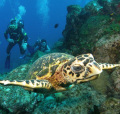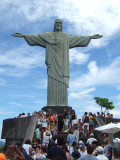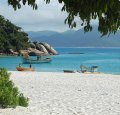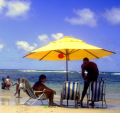Salvador
 Friday, February 5, 2010 at 08:40PM
Friday, February 5, 2010 at 08:40PM 
Our Lady of the Rosary of the Blackmen. Photo: llvsboston. (For Original Click Image)
Salvador for short, or São Salvador da Bahia de Todos os Santos to give it its historic name (meaning Holy Saviour of All Saints Bay) is the Capital City of the state of Bahia. It is known as Brazil’s capital of happiness due to the street carnivals, numerous outdoor parties and of course its easygoing, laid back population. It is the 3rd most populous City of Brazil and is often referred to as just Bahia or Salvador. It was also the first colonial capital of Brazil.
Over 80% of the metropolitan population of Salvador has Black African ancestry. This influence is clearly reflected in the cuisine of the area, along with the music and architectural styles. The cultural practices and celebrations can also trace their routes to Africa.
The centre of Salvador, Pelourinho, is renowned for its Portuguese colonial architecture, with some monuments dating back to the 17th Century. This is why it was declared a World Heritage Site by UNESCO in 1985.
Located on a peninsular formed by the Bay on one side and the Atlantic Ocean on the other, Salvador’s terrain is diverse ranging from flat near the beaches to rolling hills and mountains further to the north. The bay gets its name from being founded on All Saints Day. It forms a natural harbour and is a major port, lying in the heart of the rich agricultural and industrial region of Brazil.
Elavator. Photo: A. Joukowski (click image for original).
The City is divided by an 85m high escarpment into the (Upper Town), Cidade Alta and the (Lower Town) Cidade Baixa. The first elevator installed in Brazil (Elevador Lacerda) connects the two parts. The elevator was installed in 1873 and has had several upgrades since. The Upper Town contains most administrative buildings and the city’s Cathedral
Maps
We have mapped recommended accommodations, colour coded by price bracket (budget, moderate or luxury) on an interactive Accommodations Map.
Short History
The indigenous people of the land, the Gé, were ousted by the Tupinambá who occupied the land when the first European expeditions discovered Brazil.
On 21st April 1500 the fleet of Pedro Alvares Cabral anchored at what is now Porto Seguro in Bahia. It is unclear as to whether he was blown of course and landed here by accident, or if he had been instructed by the King of Portugal to lay claim to the land for the Portuguese. Cabral thought that he had landed on an island, not a continent, so when he went ashore himself on 22nd April he named the land Ilha da Vera Cruz (Island of the True Cross). Upon realisation of his error the name was changed to Terra da Vera Cruz (Land of the True Cross)
On November 1st 1501 (All Saints Day) Amerigo Vespucci put into an enormous bay which they named Baia de Todos os Santos – All Saints Bay.
The Catholic Church of Portugal funded the explorers on condition that they convert any indigenous people to their faith. Needless to say this was made difficult by their enslavement by the Portuguese. The natives resisted the Portuguese and, when 2 ships sunk off the coast (one in in 1509 and one in 1537), the fate of two survivors was very different. The first was liked by the folk and so he was well treated, and was even given the daughter (Paraguassu) of the Chief of the tribe as a bride. He built the first church in Salvador (Nossa Senhora da Graça) and Paraguassu’s remains still lay in the church which is grander now than it originally was. The second of the survivors from the wreckages was not so lucky. He was Captain Coutinho. He was saved from drowning, but when the natives took a dislike to him they ate him!
 Later the Portuguese sent Thome de Souza to create a Governorship of Brazil. He created a Capital and built a Palace for the administration work to be carried out from. Today this is called the Palacio Rio Branco and stands in a commanding position in the upper town overlooking the town square and the bay.
Later the Portuguese sent Thome de Souza to create a Governorship of Brazil. He created a Capital and built a Palace for the administration work to be carried out from. Today this is called the Palacio Rio Branco and stands in a commanding position in the upper town overlooking the town square and the bay.
The origin of the widely used word ‘brega’ belongs here as well. De Souza was accompanied by Jesuits to spread the word of Christianity to their ‘new lands’. Their leader was Manoel da Nóbrega. Salvador honoured Nobrega by bestowing a street with his name. Unfortunately the street became infamous for brothels and low class bars and the shortened surname has now become synonymous with low class products, places and people.
The main wealth of Brazil had come from brazilwood, or rather the red dye extracted from it´s sap, but this was to be massively overtaken by the sugar industry! This was planted and harvested in huge plantations in the Northseast. Unfortunately, the workforce was provided in the form of slavery. Most slaves were African, as they proved to be less prone to desease and more productive than the indigenous population. The slavery lead to several quashed uprisings, escapes and the deaths of slaves and Governors alike. Eventually, in 1888, with the abolition of slavery the area became more harmonious and nowadays the African ancestry is celebrated in various festivals throughout the year.
Do Not Miss
Ivete Sangalo, Carnival 2009. Photo: oficialivetesangalo (click image for original)
As Salvador is home to the largest Carnival in the world (Guinness book of Records), it is not surprising that all year round there are dancers, bands and musicians practising for the next event. You are bound to see groups of Samba Reggae drummers practising on street corners, in gardens or anywhere else they fancy. Samba is recognized throughout the world as ‘Brazil’, so this is the place to be for real Samba beats and dancing. The folk dance art of Capoeira was developed in nearby Quilombo dos Palmares and is now widely practised in the North East of Brazil. It is made up of music, dance and martial art moves. Typically a group form a wide circle with participants taking turns to go to the middle, to dance, sing or ‘spar’ with each other. Then there is Candomble which originated in Salvador. This is a type of religion which combines healing, dancing, trance and percussion in its displays.
Gifts for Yemanja. Photo kxande2. (click image for original)
So it is inevitable that at some point during your stay here you will witness some of the above sounds and sights, but why not take the plunge and get lessons so you can take part in the activities? There are various tutors who would be willing to take on novice students to their art forms. Let your hair down and go with the beat!
Other Top Attractions
Marina, Salvador: Photo: CMarino (click image for original).
The Beaches and the islands of Salvador are one of the biggest attractions for visitors. Head down to the port area and you will find a number of operators who will offer various trips around the many islands. They will display the cost and the duration of the trips, so you can choose one to suit your requirements. We would recommend a schooner trip for a 1 day excursion. The trips usuallyvisit two of the islands and some of the fantastic beaches, with the opportunity to bathe in the crystal clear waters when the boat anchors off shore. There is live music on board with fruits and drinks to help you into the holiday mood.
Pátio de São Francisco. Photo: Rodrigo Cantarelli (click image for original)
The historic centre of Salvador contains many architectural gems. High on the agenda should be A Igreja de Nossa Senhora do Rosário dos Pretos (The Church Our Lady of the Rosary of the Blacks). It is located at the top of R. das Portas do Carmo and dominates the Largo do Pelourinho. The church was built over a period of a hundred years or so beginning in 1704, by the enslaved members of O Irmandade de Nossa Senhora do Rosário dos Homens Pretos do Pelourinho (The Brotherhood of Our Lady of the Rosary of the Black Men of Pelourinho). This was built by them, for their use as they were not permitted inside other churches. Tuesday evening mass (at 6pm) is accompanied by African drumming.
Between R. da Oracao and R. Sao Fransisco lie the Church of Saint Francis (Igreja de São Francisco) and its adjoining convent. One of the most lavish churches and well-known for its golden interior and it’s rococo gallery of saints and angels which one would be hard-pressed to find in any other church - pregnant cherubs and saints with protuberant manhoods - all carved, of course, by slaves.
O Mercado Modelo. Photo: Jairo (for original click image)
The Mercado Modelo is located in the lower city across the street from the Elevador Lacerda, and is the old Customs House now transformed into a market selling local handicrafts. If you want to buy in the Mercado Modelo be prepared to haggle, and be prepared to shake off vendors insistent on selling something to you whether you want to buy or not. Behind the Mercado Modelo the drumming from the Capoeira reflects from the overhanging roof makes an enthralling atmosphere, but conversation difficult.
For another taste of Salvador’s colonial past visit the Carlos Costa Pinto Museum, a house museum which offers a large collection of colonial furniture, antique jewellery, and gold and silver amulets that were given to female slaves. This is located at Avenida Sete de Setembro, 2490, Vitória.

The Museum of Modern Art stands as one of the most important of the country, characterized as a dynamic and vital centre of information, education and art production. The collection, comprising paintings, prints, photographs, drawings and sculptures of pioneers of modernism and master of fine arts, home to names like Amaral, Portinari, Flávio de Carvalho, Di Cavalcanti, Rubem Valentim, Ianelli, Carybe, Mario Cravo, Sante Scaldaferri and other internationally renowned artists. Also attached to this is the Solar de União – colonial era sugar plantation structures including a house, chapel and mil, which give an idea of life in those days. This is also the best place to watch the sunset and also take in a Jazz concert some Saturday evenings.
Museu de Arte de Bahia and Museu de Arte Sacre are also well worth visiting as is the big blue house at Largo do Pelourinho which is dedicated to the famous Bahian writer Zelia Gattai.
For something less cultural, you could always try learning to surf with the SurfCamp team. A safe environment on some very picturesque beaches along the Bahian coast. A fix of adrenalin and a breath taking experience with views to match.
Accommodation


Our accommodation lists are by price range, Budget, Moderate or Luxury. You can see them all, colour coded, in our interactive Accommodation Map
Tours

Tours in Salvador include tours to discover the city and its rich heritage with other beach and relaxation tours along the coast and the islands off the coast. See Tours in Salvador
Recommended Restaurants

The typical food of Salvador is quite distinct from that in other parts of Brazil. Of course, being a costal city, it includes a lot of fish and seafood, but cooked with a strong African influence. Also being a tourist destination, there are several restaurants serving international cuisine. Some are of a very high standard.
Our recommendation is based on a survey of local opinion condusted annually for Brazil´s largest cistulation magazine Veja. Their "Best of" guide recommends restaurnats in various categories e.g. "Best for Meat". Whilst not comprehensive, we believe it is a good starting point for a tourist, but we would love to get your suggestions of restaurants we should add, and comments on those we list.
Follow the link to see the Restaurant Recommendations
Bars & Nightlife
There are many bars and places to enjoy the evening in salvador. Our listing highlights the best as selected by locals for Veja the largest circulation magazine in Brazil. Follow the link our Bar Listing
Events
Coming Soon
Getting There
By Plane
Salvador is served by international Aeroporto International Deputado Luis Eduardo Magalhaes (Airport code: SSA) located in the suburbs of Salvador 28km from the center, (approx 40mins by taxi, in average driving conditions and off-peak).
Most hotels and pousadas will arrange a transfer on request, but this will be at an additional charge, with a commission. This is not necessary if you are arriving at a reasonable time, but perhaps advisable if you are going to be a late arrival. The alternative is a licensed airport taxi which operates to a list of standard charges. It is not advisable to take an un-licensed taxi.
By Bus
The Main Bus station or Rodviária is 5 km from city center next to Salvador's largest shopping centre Iguatemi. The Terminal , is usually simply known as Rodoviaria. (website)
 Brazzil Travel | Comments Off |
Brazzil Travel | Comments Off | 

















